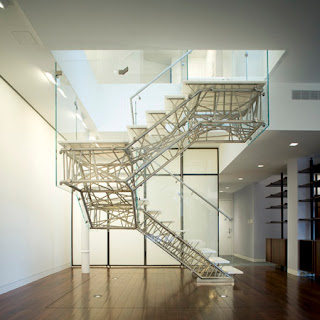Retail store design
Level 5
Module: 5CTA1039
Technology 2: Detail
Credits: 15
Semester A
Module Leader: Alexandra Glazko
Tutor: Alexandra Glazko
Submission date: 12 January 2012
 |
| Genetic Stair by Caliper Studio |
Introduction:
'Materials, structure, detailing’ focuses on the construction and how the detailing of the design is accomplished through consideration of the materials and structure required to realise the finished design project.
Brief:
In order for interior designers to make significant interventions within the construction of buildings, furniture or any spatial creation, it is necessary to have an understanding of the structural implications of any design and how materials respond to the required performance within the design. For example, the use of glass, either as a structural element or a glazing/decorative component, requires an appreciation of how glass behaves in different circumstances that can have serious implications for health and safety.
There is no substitute to actual practice for understanding materials and structure but in this project you will combine a selection of real/familiar building elements with textbook and tutorial assistance to produce detailing for proposed Retail Store Design concept (5CTA1040 Module). You will need to examine each area of proposed concept noting the structure, materials and components used in its construction. Further hand sketches and rough detail drawing should be used to develop the complete detail drawings.
Task:
You will need to deeply research materials and structure chosen for your proposed Retail store design concept. You will then be required to complete a set of drawings in VectorWorks to present three different areas of proposed concept. Choose the scale appropriate for each detail for presentation on an A3 sheet. Details will be usually within the following range 1:1, 1:2, 1:5, 1:10 and 1:20 for clarification of the context of the detail. You must produce a plan, elevation and section for each element and include a large-scale detail – 1:1 or 1:2 for each. Oblique, isometric, assembly/exploded views may be used where necessary.
References:
Reekie, Fraser Reekie’s Architectural Drawing
Ching, Francis D.K Building Construction Illustrated
Ching, Francis D.K, Architectural Graphics
Porter, Tom The Architect’s Eye: Visualisation and Depiction of Space in Architecture
Wang, Thomas C. Plan and Section Drawing
Styles, Keith Working drawings Handbook
Weston, Richard Plans, Sections and Elevations: Key Buildings of the 20th Century
Osbourn, Derek Introduction to Building Longman
McMorrough, Julia Materials Structures Standards
Ching, Francis D.K and Binggeli, Corky Interior Design Illustrated
Kilmer, W. Otie and Kilmer, Rosemary Construction Drawings and details for Interiors
Ching, Francis D.K Architecture: Form, Space, and Order
Assessment Criteria:
- Completion of detail drawings – hand-drawn sketches and Vectorworks
- Completion of A4 document on researched materials and construction
- Showing of an understanding of drawing conventions i.e. line weights, symbols and materials hatching, and descriptive text terminology.
- Demonstration of an ability to be resourceful and creative in using the software in the design process.
- Demonstration of an ability to manage study time which includes attendance and commitment.
- Quality of all submitted work in terms of its accuracy and final presentation
Submission Requirement:
· Three A3 drawings of each of the chosen building elements with details and descriptive text.
· Supporting sketch drawings showing your initial working out of the details.
· A4 document showing an analysis of the materials and components
Please Note:
Failure of non-submission of this assignment results in failing the module.
All work to be saved on digital backup file!
Please DOWNLOAD PDF version of the brief from here or check Studynet for a word format


No comments:
Post a Comment